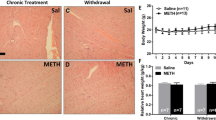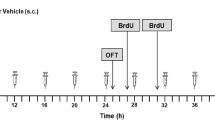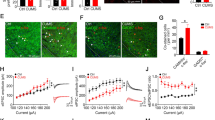Abstract
We previously demonstrated an increase in Fos expression in the heart during morphine withdrawal. In the present study we examined the role of β- and α-adrenoceptors in naloxone-precipitated increases in Fos expression in the heart. Dependence on morphine was induced by 7-day chronic subcutaneous implantation of six morphine pellets (75 mg). Morphine withdrawal was precipitated by administration of naloxone (5 mg/kg subcutaneously) on day 8. Using immunohistochemical staining of Fos, the present results indicate that morphine withdrawal induced marked Fos immunoreactivity (Fos-IR) within the cardiomyocyte nuclei. Moreover, Western blot analysis revealed a peak expression of c-fos in the right and left ventricles after naloxone-precipitated withdrawal in parallel with an increase in noradrenaline (NA) turnover. In the second study, the effects of the administration of adrenoceptor antagonists on withdrawal-induced Fos expression in the heart were studied. Pretreatment with the β antagonist, propranolol (3 mg/kg intraperitoneally) or α1-adrenoceptor antagonist, prazosin (1 mg/kg intraperitoneally) did not block the marked Fos-IR or the hyperactivity of catecholaminergic neurons observed in the heart during withdrawal. However, pre-treatment with α2-adrenoceptor antagonist, yohimbine (1 mg/kg intraperitoneally), 20 min before naloxone administration to morphine-dependent rats antagonized Fos expression and the enhancement of NA turnover in the heart. Collectively, these results suggest that noradrenergic neurons in the heart are active during morphine withdrawal, and that activation of transcriptional responses mediated by Fos are dependent upon cardiac α2-adrenoceptor.






Similar content being viewed by others
References
Aanta R, Marjamäki A, Scheinin M (1995) Molecular pharmacology of alpha 2-adrenoreceptor subtypes. Ann Med 27:439–449
Angel P, Karin M (1991) Phorbol ester-inducible genes contain a common Cis element recognized by a TPA-modulated trans-acting factor. Biochem Biophys Acta 1072:129–157
Blendy JA, Maldonado R (1998) Genetic analysis of drug addiction: the role of cAMP response element binding proteins. J Mol Med 76:104–110
Caillé S, Espejo EF, Reneric JP, Cador M, Koob GF, Stinus L (1999) Total neurochemical lesion of noradrenergic neurons of the locus does not alter either naloxone-precipitated or spontaneous opiate withdrawal nor does it influence ability of clonidine to reverse opiate withdrawal. J Pharmacol Exp Ther 290:881–892
Cicero T, Meyer ER, Bell RD (1974) Effects of phenoxybenzamine on the narcotic withdrawal syndrome in the rat. Neuropharmacology 13:601–607
Curran E, Akil H, Watson S (1996) Psychomotor stimulant-and opiate-induced c-fos mRNA expression patterns in the rat forebrain: comparisons between acute drug treatment and a drug challenge in sensitised animals. Neurochem Res 21:1425–1435
Euger M, Tommasello A, Schwartz R, Clinton M (1998) Clonidine use and abuse among methadone program applicants and patients. J Subst Abuse Treat 15:589–593
Fuertes G, Laorden ML, Milanés MV (2000) Noradrenergic and dopaminergic activity in the hypothalamic paraventricular nucleus after naloxone-induced morphine withdrawal. Neuroendocrinology 71:60–67
González-Cuello A, Milanés MV, Castells MT, Laorden ML (2003) Activation of c-fos expression in the heart after morphine but not U-50,488H withdrawal. Br J Pharmacol 138:626–633
Hannan RD, West AK (1991) Adrenergic agents, but not triiodo-L-thyronine induce c-fos expression in the rat heart. Basic Res Cardiol 86:154–164
Hannan RD, Stennard FA, West AK (1993) Expression of c-fos and related genes in the rat heart in response to norepinephrine. J Mol Cell Cardiol 25:1137–1148
Laorden ML, Castells MT, Martínez MD, Martínez PJ, Milanés MV (2000a) Activation of c-fos expression in hypothalamic nuclei by mu-and kappa-receptor agonists. Correlation with catecholaminergic activity in the hypothalamic paraventricular nucleus. Endocrinology 141:1366–1376
Laorden ML, Fuertes G, González-Cuello A, Milanés MV (2000b) Changes in catecholaminergic pathways innervating paraventricular nucleus and pituitary-adrenal axis response during morphine dependence: implication of α1-and α2-adrenoceptors. J Pharmacol Exp Ther 293:578–584
Laorden ML, Castells MT, Milanés MV (2002a) Effects of morphine and morphine withdrawal on brainstem neurons innervating hypothalamic nuclei that control the pituitary-adrenocortical axis in rats. Br J Pharmacol 136:67–75
Laorden ML, Nuñez C, Almela P, Milanés MV (2002b) Morphine withdrawal-induced c-fos expression in the hypothalamic paraventricular nucleus is dependent on the activation of catecholaminergic neurones. J Neurochem 83:132–140
Larsen TJ, Skar R, Frotjold EK, Haukanes K, Greve G, Saetersdal T (1998) Regional activation of the immediate-early response gene c-fos in infarcted rat hearts. Int J Exp Pathol 79:163–172
Maldonado R (1997) Participation of noradrenergic pathways in the expression of opiate withdrawal: biochemical and pharmacological evidence. Neurosci Biobehav Rev 1:91–104
Milanés MV, Laorden ML (1998) Effects of U-50,488H withdrawal on catecholaminergic neurones of the rat ventricle. Br J Pharmacol 124:1060–1064
Milanés MV, Laorden ML (2000) Changes in catecholaminergic pathways innervating the rat heart ventricle during morphine dependence. Involvement of α1-and α2-adrenoceptors. Eur J Pharmacol 397:311–318
Milanés MV, Laorden ML, Chapleur-Chateau M, Burlet A (1998) Alterations in corticotropin-releasing factor and vasopressin content in rat brain during morphine withdrawal. Correlation with hypothalamic noradrenergic pituitary-adrenal response. J Pharmacol Exp Ther 285:700–706
Milanés MV, Fuente T, Laorden ML (2000) Catecholaminergic activity and 3’,5’-cyclic adenosine monophosphate levels in heart right ventricle after naloxone induced withdrawal. Naunyn-Schmiedebergs Arch Pharmacol 361:61–66
Millan MG, Newman-Tancredi A, Audinot V, Cussac D, Lejeune F, Nicolas JP, Coge F, Galizzi JP, Boutin JA, Rivet JM, Dekeyne A, Gobert A (2000) Agonist and antagonist actions of yohimbine as compared to fluparoxan at alpha (2)-adrenergic receptors (AR)s, serotonin (5HT) (1A9, 5-HT (1B9, 5-HT (1D) and dopamine D(2) and D(3) receptors. Significance for the modulation of frontocortical monoaminergic transmission and depressive states. Synapse 35:79–95
Mizukami Y, Yoshida K (1997) Mitogen-activated prokinase translocates to the nucleus during ischaemia and activated during reperfusion. Biochemistry 323:785–790
Morales L, Pérez-García C, Aguacil LF (2001) Effects of yohimbine on the antinociceptive and place conditioning effects of opioid agonists in rodents. Br J Pharmacol 133:172–178
Morgan JI, Curran T (1991) Stimulus transcription coupling in the nervous system: involvement of the inducible proto-oncogenes fos and jun. Ann Rev Neurosci 14:421–451
Neal BS, Sparber SB (1985) Detanserin and pirenperone attenuate morphine withdrawal induced suppression of food reinforced autoshaped behaviour. Pharmacologist 27:224–230
Nestler EJ (1992) Molecular mechanism of drug addiction. J Neurosci 278:58–63
Nestler EJ, Aghajanian CK (1997) Molecular and cellular basis of addiction. Science 278:58–63
Rabadán JV, Milanés MV, Laorden ML (1998) Changes in right atria catecholamines content in naive rats and after naloxone-induced withdrawal. Br J Anaesth 80:354–359
Sastre-Coll A, Esteben S, García-Sevilla JA (2002) Supersensitivity of 5-HT1A-autoreceptors and α2-adrenoceptors regulating monoamine synthesis in the brain of morphine dependent rats. Naunyn-Schmiedebergs Arch Pharmacol 365:210–219
Singh VP, Jain NK, Kulkarni SK (2003) Fluoxetine suppresses morphine tolerance and dependence: modulation of NO-cGMP/DA/serotoninergic pathways. Methods Find Exp Clin Pharmacol 25:273–280
Taylor JR, Lewis JD, Elsworth JC, Charney DS, Jablons DR, Roth RH, Redmond DE, Maas JW (1991) Yohimbine co-treatment during chronic morphine administration attenuates naloxone precipitated withdrawal without diminishing tail-lick analgesia in rats. Psychopharmacology 103:407–414
Ueyama T, Umemoto S, Senba E (1996) Immobilization stress induces c-fos and c-jun immediate early genes expression in the heart. Life Sci 59:339–347
Ueyama T, Yoshida KI, Senba E (1999) Emotional stress induced immediate-early gene expression in rat heart via activation of alpha and beta-adrenoceptors. Am J Physiol 277:H1553–H1561
Valeri P, Martinelli B, Pimpinella G, Severini C (1988) Effects of dapripazole, clonidine and yohimbine on the development of dependence and withdrawal behaviour in mice. Naunyn-Schmiedebergs Arch Pharmacol 23:73–77
Van der Laan JW (1999) Effects of α2-agonists on morphine withdrawal behaviour: potentiation of jumping mediated by α2 receptors. Naunyn-Schmiedebergs Arch Pharmacol 359:293–298
Wiechelman KJ, Braund RD, Fitzpatrick JD (1988) Investigation of the bicinchoninic acid protein assay: identification of the groups responsible for colour formation. Anal Biochem 175:231–237
Williams JT, Christie MJ, Manzoni O (2001) Cellular and synaptic adaptations mediating opioid dependence. Physiol Rev 81:299–343
Acknowledgments
This work was supported by CICYT(SAF 99–0047; SAF 2002–00763), DGEST (PM99–0140) and Fundación Séneca, Comunidad Autónoma de Murcia (PB 18FS/99; PI-52/00806/FS01).
Author information
Authors and Affiliations
Corresponding author
Rights and permissions
About this article
Cite this article
González-Cuello, A., Milanés, M.V., Aviles, M. et al. Changes in c-fos expression in the rat heart during morphine withdrawal. Involvement of α2-adrenoceptors. Naunyn-Schmiedeberg's Arch Pharmacol 370, 17–25 (2004). https://doi.org/10.1007/s00210-004-0946-1
Received:
Accepted:
Published:
Issue Date:
DOI: https://doi.org/10.1007/s00210-004-0946-1




